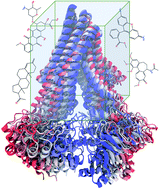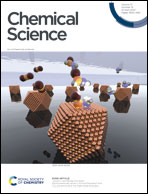Extended-ensemble docking to probe dynamic variation of ligand binding sites during large-scale structural changes of proteins†
Abstract
Proteins can sample a broad landscape as they undergo conformational transition between different functional states. At the same time, as key players in almost all cellular processes, proteins are important drug targets. Considering the different conformational states of a protein is therefore central for a successful drug-design strategy. Here we introduce a novel docking protocol, termed extended-ensemble docking, pertaining to proteins that undergo large-scale (global) conformational changes during their function. In its application to multidrug ABC-transporter P-glycoprotein (Pgp), extensive non-equilibrium molecular dynamics simulations employing system-specific collective variables are first used to describe the transition cycle of the transporter. An extended set of conformations (extended ensemble) representing the full transition cycle between the inward- and the outward-facing states is then used to seed high-throughput docking calculations of known substrates, non-substrates, and modulators of the transporter. Large differences are predicted in the binding affinities to different conformations, with compounds showing stronger binding affinities to intermediate conformations compared to the starting crystal structure. Hierarchical clustering of the binding modes shows all ligands preferably bind to the large central cavity of the protein, formed at the apex of the transmembrane domain (TMD), whereas only small binding populations are observed in the previously described R and H sites present within the individual TMD leaflets. Based on the results, the central cavity is further divided into two major subsites, first preferably binding smaller substrates and high-affinity inhibitors, whereas the second one shows preference for larger substrates and low-affinity modulators. These central subsites along with the low-affinity interaction sites present within the individual TMD leaflets may respectively correspond to the proposed high- and low-affinity binding sites in Pgp. We propose further an optimization strategy for developing more potent inhibitors of Pgp, based on increasing its specificity to the extended ensemble of the protein, instead of using a single protein structure, as well as its selectivity for the high-affinity binding site. In contrast to earlier in silico studies using single static structures of Pgp, our results show better agreement with experimental studies, pointing to the importance of incorporating the global conformational flexibility of proteins in future drug-discovery endeavors.



 Please wait while we load your content...
Please wait while we load your content...